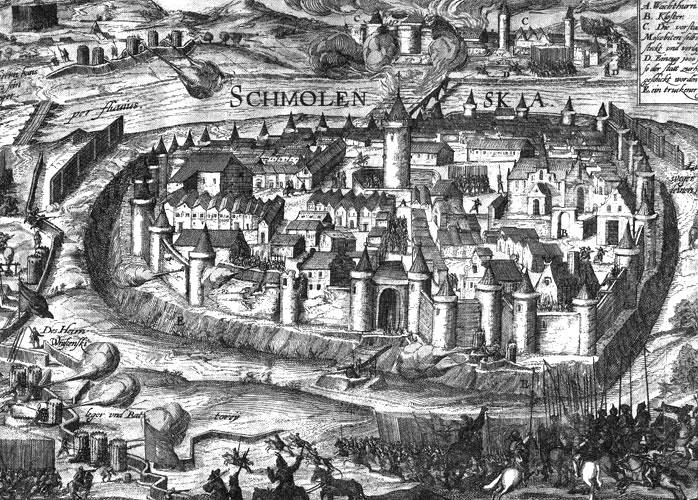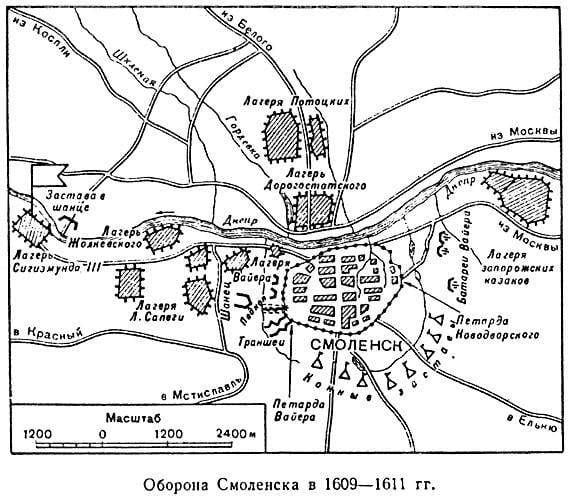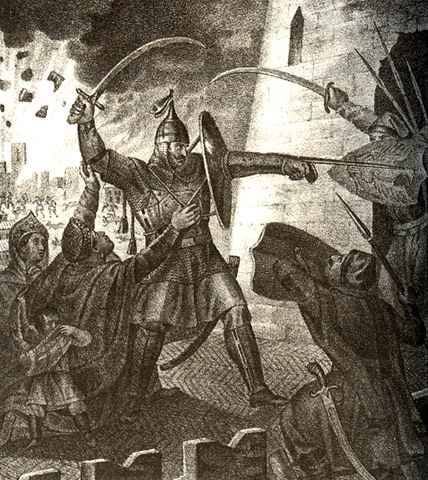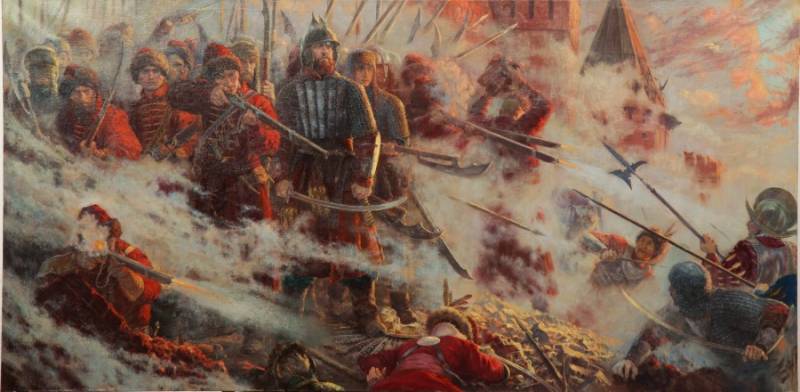410 years ago began the heroic defense of Smolensk
Defense of Smolensk. Artist V. Kireev
The 20 month-long defense of Smolensk was of great political and strategic importance. From the second half of the 1610 of the year, the Smolensk garrison turned out to be the main force that organizedly and openly fought against the interventionists, which was of great moral importance to Russia. In addition, the city for two years distracted the main forces of the Polish invaders, showing an example of the struggle of the rest of the country.
Polish intervention
The Polish-Lithuanian feudal lords, with the active participation of the Jesuits and with the support of the Polish king Sigismund III, took advantage of the situation of the Time of Troubles in the Russian Empire and began the intervention. Initially, during the impostors of False Dmitry I and False Dmitry II, Polish robbers - pans and gentry "walked" on Russian soil. Various Lisovsky, Ruzhinsky, Makhovetsky, Sapieha, Vishnevetsky, etc. Their main interest was profit. Which did not stop to cover the passion for gold with loud patriotic and religious slogans. For them, a weak ruler in Moscow was beneficial, who would not interfere with robbing, and even give gifts, lands for help.
Polish nobles and magnates, like the king, sought to colonize Russia, at least its western part, and to catholicize the people, subjugating the Russians to the throne of the pope. In this situation, the king and the Polish elite received a huge jackpot - all Russian wealth, land, Russian - slaves-servants of the Polish feudal lords. But at the same time, the interests of the magnates and the king diverged. The pans sought to ensure that all the benefits of the occupation went to them only, and the royal power not only did not increase at the expense of the Russian lands, but, on the contrary, weakened even more. Accordingly, Sigismund saw in the Russian Empire his personal estate, in which it would be possible to rule without the intervention of the Polish Sejm, where the nobility, which was driven by magnates, ruled. That is, both the king and the magnates were all for a religious union (absorption) with Russia, but the magnates were for a state union, and the king was for a personal one. In 1606 - 1607 years. part of the gentry launched a war against the king, which delayed the royal army's invasion of Russia in the Time of Troubles for almost three years.
Before the invasion of Rus by the royal army, the Polish-Lithuanian gentry constituted the professional, well-armed core of the army of the second impostor. False Dmitry II was to implement a church union, subjugate the Russian state to the Roman throne and Poland, and transfer the Russian capital closer to the western border. Also provide the highest and most important state posts to Catholics, Uniates and supporters of the union from the Russian nobility.
In June 1608, the troops of False Dmitry II camped at Tushin. From here, the forces of the impostor controlled the Smolensk and Tverskaya roads, approaches to Moscow from the north-west. The government of Vasily Shuisky had a large army in Moscow. Therefore, the Tushins could not storm the city. In turn, Shuisky was afraid to go on the offensive because of the unreliability of part of the governor and the boyars, the lack of combat-ready troops and their moral instability. Many boyars and nobles several times moved from camp to camp. In Tushino there was its own “king”, government, treasury, governing bodies (orders), army. Some cities and lands subordinated to Moscow, handed over people, supplies and money there, while others - to the “Tushino thief”.
At the end of July 1608, the embassy of the Shuisky government managed to conclude a truce with Sigismund III for the 3 of the year and 11 of the month. The Polish government was obliged to withdraw all Polish troops from the borders of the Russian Empire, and the Shuisky government freed Polish lords, both prisoners and those detained after the murder of False Dmitry I. However, most of those released, including the Mniszek family, along with Marina (wife of False Dmitry I), were “Intercepted” on the way to Poland and ended up in the Tushino camp. Reinforcements from the Commonwealth continued to arrive to False Dmitry II. So at the end of August a large detachment of Jan Sapieha arrived in Tushino. By the fall of 1608, the Poles totaled about 16 thousand horsemen in the Tushino camp, and all over Russia up to 40 thousand, and even more allied Cossacks.
Thus, the Polish-Lithuanian feudal lords had an entire army in the Russian state. The Polish command tried to solve two main problems: 1) to extend the power of the Tushino "Tsar" to the richest regions of the Russian land, which had a formal reason for their robbery; 2) create a full-fledged blockade of Moscow in order to cut it off from other cities, interrupt the arrival of reinforcements and the supply of food, which led to the fall of the Russian capital. Therefore, the detachments of the Polish-Lithuanian gentry, the "thieves' Cossacks" were sent from Tushin to the south, east and north of Moscow, forcing the population of cities to "kiss the cross to the thief", that is, swear an oath to False Dmitry II. Resistance at this time they almost did not meet. Many cities "kissed the cross from tears with tears." But some cities like Rostov and Kolomna resisted. As a result, by the end of the year, a significant part of the Russian land fell under the control of the “thief”. But it was a short-term success. The predatory actions of Polish robbers and other "thieves" very quickly provoked a response from the Russian people, which everywhere began to resist and organize independently, putting forward experienced and decisive leaders. Local zemstvo self-government, created under Ivan the Terrible, played a huge role in creating militias and eliminating the Time of Troubles in the country.
The Tushins failed to solve the second strategic task - to completely block Moscow. Khmelevsky’s detachment, which was supposed to take Kolomna and cut Moscow off from the Ryazan region, was defeated by the Kolomna people and Pozharsky’s detachment. Sapieha’s detachment besieged the Trinity-Sergius Monastery (at that time it was a powerful fortress), through which Moscow’s communications with the north went. The Lisovsky detachment came up to the same place. Here the Poles got stuck in a siege of the monastery until January 1610 and were never able to take it (The ruin of the Russian land. Heroic defense of the Trinity Monastery of St. Sergius).
Expanding the scale of the people's war. Success of Skopin-Shuisky
Meanwhile, resistance to the Poles and their "thieves" intensified, who levied taxes on cities and villages, and most often simply plundered the people. The impostor's social base has declined. The upsurge of the national liberation struggle began. The successful defense of Rostov and Kolomna, the heroic defense of the Trinity-Sergius Monastery became an example for others. Posad-peasant population, service people of the North and the Upper Volga region were the first to repel the onslaught of “thieves”. At the same time, the Volga region rose against the Tushins and Poles. Nizhny Novgorod didn’t let the Tushins in, the Galician militia fought off Kostroma, a hard fight went over Yaroslavl, where the Poles created a base for themselves. The people's war led to the dispersal of the forces of the Polish-Lithuanian feudal lords, who, solving a lot of tactical tasks, could not concentrate on strategic ones.
In the meantime, the Shuisky government decided to lean against Sweden, which was the enemy of the Polish-Lithuanian Commonwealth, and repeatedly offered assistance in the fight against the Poles in the fight against Tushins. It is clear that the help was not free - the Swedes wanted to chop off the north-western regions from Russia with Pskov, Novgorod, Karelia, etc. Apart from the monetary payment. At the beginning of 1609 in Vyborg, a Russian-Swedish military alliance was concluded against the Commonwealth. Sweden provided several thousand mercenaries to Moscow for a set fee (there were few Swedes themselves, mostly fighters from Western Europe). In response, the Shuisky government refused claims to Livonia and ceded the Swedes to the city of Korel with the county. The Russian-Swedish army led by Skopin-Shuisky and Delagardi in May 1609 came out of Novgorod with the goal of liberating Moscow. In the current strategic situation, when Skopin’s troops advanced from the north and the scale of the people's war weakened the Tushino camp, the Tushins tried to take Moscow before the approach of ratification of Skopin-Shuisky. In the battles on the Khodynsky field on 5 and 25 on July 1609, the Tushins were defeated. The defeat at Khodynka, the approach of Skopin’s troops and the invasion of the Polish army led by the king (many Polish troops were recalled to the royal army), predetermined the collapse of the Tushino camp.
The invasion of the Polish king
An agreement between the Shuisky government and Sweden, the enemy of Poland, gave King Sigismund a formal reason for a war with Russia. Sigismund himself decided to start a war, without resorting to the Sejm. Polish laws allowed the king to wage war on his own if no additional taxes were introduced. For the invasion, the Polish high command outlined the Smolensk direction, although the hetman Zholkevsky suggested the king move through Seversky land. The first strategic target was Smolensk, which closed the way to Moscow. The Polish command hoped to quickly seize the Smolensk fortress and, during a further offensive, strengthen its army with the Polish-gentry detachments of the decaying Tushino camp, and take Moscow.
However, all these rainbow plans were destroyed by the fierce resistance of the Smolyan. In addition, the Polish king was unable to assemble a large army. They planned to gather up to 30 thousand soldiers, but they recruited only about 12 thousand people. At the same time, the Poles had little infantry and artillery (all 30 guns) to storm or besiege such a strong fortress as Smolensk. They hoped for change. The military council decided not to wait for the arrival of all forces and to begin the offensive until winter came. On September 9 (19), breaking the ceasefire, without declaring war, Polish troops crossed the border, and September 13 (23) occupied Krasny, from where Sigismund sent a letter to Moscow. The Polish king wrote that he enters the borders of the Russian kingdom as a deliverer from troubles and bloodshed, allegedly at the call of the Russian people, and most of all is happy about the preservation of the Orthodox faith. It is clear that they did not believe him. Sigismund also sent the governor of Smolensk to Mikhail Shein a demand for surrender. The Russian governor didn’t answer anything to the proposal of the Poles, but declared to the Pole who had come to him that if he came up with such a proposal for the second time, they would give him drink the Dnieper’s water ”(that is, drown).
On September 16 (26), Lithuanian troops came to Smolensk under the command of Leo Sapieha, and on September 19 (29) the main forces of Sigismund III approached. At the end of September, about 10 thousand Cossacks, an indefinite number of Lithuanian Tatars, joined the army of Sigismund. That is, Sigismund had a lot of cavalry to quickly go to Moscow, but there was little infantry and artillery (they didn’t take heavy siege artillery at all) to go on an assault or conduct a proper siege.

Siege of Smolensk in 1609 — 1611
The beginning of the defense of the Smolensk fortress
The Polish command greatly underestimated the enemy. Although the garrison of Smolensk did not exceed 5 thousand people (while the most combat-ready forces, archers and nobles, left Smolensk to help Skopin), he had high morale and relied on powerful fortifications. Smolensk fortress was built in 1586 1602 years. under the guidance of the famous builder of Russian fortresses of the city master Fedor Kon). The total length of the fortress wall reached 6,5 km, height - 13 – 19 m, width - 5 – 6 m. A powerful foundation was laid with a width of up to 6,5 m and a depth of more than 4 m, which complicated the enemy’s mine attack. The wall had 38 towers, including 9 gateways. The height of the towers reached 21 m, and the Frolovskaya tower near the Dnieper - 33 m. “Rumors” were prepared outside the fortress wall for timely detection of enemy mine work. There were about 170 guns in the armament of the fortress, they were installed in the embrasures of the "plantar battle", "middle battle", "another middle battle" and in the "upper battle" (between the battlements of the wall). The fortress had good supplies of spare guns and a hand gun weapons and ammunition. There was food in the warehouses, but it was not enough for a long siege.
Smolensk governor Mikhail Borisovich Shein was a brave, determined and experienced commander. Already in July, Shein began to receive information that the enemy was preparing an offensive and took a number of measures to strengthen the defense of the fortress. Work was carried out to prepare the fortress for defense, gathering affluent people (peasants) from the nobles and children of the boyars to strengthen the garrison. Shein divided the entire garrison into siege (about 2 thousand people) and march (about 3,5 thousand people) groups. The siege group was divided into 38 units (according to the number of towers) of approximately 50 warriors in each unit who defended their tower and a section of the wall with it. The sortie group made up a general reserve, which was of great importance for the defense of so much great fortress. During the defense of Smolensk, the garrison was constantly replenished from the population of the city, the number of which historians determine in 40 – 80 thousand people, including the inhabitants of the posad, who were burned when the enemy approached.
It is not surprising that the siege from the very beginning went unsuccessfully. Six Smolensk brave men on a boat in broad daylight crossed the Dnieper and made their way to the royal camp, grabbed the royal banner and safely returned to the city. The Polish Military Council, after studying the defense of the city, came to the conclusion that the existing forces and means did not take the fortress. Getman Zholkevsky proposed a completely reasonable solution - to leave the detachment for the sake of siege and with the main forces go to Moscow. However, Sigismund did not dare to leave behind a strong Russian fortress. It was decided to attempt an unexpected assault: quickly break into the fortress, destroying the Kopytetsk and Abraham gates with firecrackers (subversive shells). However, Shein envisioned such a scenario; wooden log houses filled with earth and stones were erected at the gate outside. Between the gates and the log cabins there was a small passage through which only one rider could pass. These log houses protected the gates from mines and shelling of enemy artillery. Therefore, the evening storm of 24 on September 1609 failed.
Polish artillery and musketeers tried to distract the Russians with their shooting. The best horse banners and infantry companies were preparing for a breakthrough. Mine with trumpeters (they should have given a signal that the path is clear), moved to the gate. Shlyakhtich Novodvorsky was able to get to the Abraham gate with a narrow passage, attached firecrackers to the gate, and the explosion broke them out. However, there were no trumpeters during the gentry, and no signal was given for the assault. The commanders of the infantry and cavalry assigned for the assault believed that the mines did not destroy the gate, since the blast had not been followed by an established pipe signal. Russian soldiers lit torches on the tower and on the wall. The lit enemy was a good target for the gunners who opened fire. The Polish infantry and cavalry, bearing losses, retreated from the gate. After this assault, the Russians strengthened their defenses: they set up palisades near the log cabins and placed strong guards in order to prevent an enemy attack.

The siege and fall of Smolensk
Polish troops began a regular siege, began shelling the fortress and mine work. However, light artillery could not harm powerful walls and towers. They sent for siege artillery to Riga. Taking into account the bad roads, the time of year (thaw, then winter), and the heavy weight of the guns, heavy artillery was delivered only in the summer of 1610. As a result, fire superiority was on the side of the defenders. The garrison of Smolensk successfully fired at the enemy. Mine work to blow up walls or towers also failed. They learned about the enemy’s works with the help of “rumors”; peasants and merchants who made their way into the city also spoke about the places of digging. The defenders launched a successful countermine work. As a result, Smolensk miners won the underground war. In addition, the garrison made successful sorties, in particular, they extracted firewood and water from the Dnieper. An active guerrilla war unfolded behind enemy lines. The siege dragged on for a long time.
The city held on. However, hopes for help were not realized. The talented commander Skopin-Shuisky, who was supposed to lead the army for a campaign near Smolensk, was poisoned in Moscow. His death was a disaster for Tsar Vasily. An army of Russians and Swedes was led by the mediocre Dmitry Shuisky. As a result, in June 1610, the hetman Zholkevsky defeated our army near Klushino with lesser forces and without artillery (Klushinskaya catastrophe of the Russian army) Shuisky ruined greed and stupidity. Foreign mercenaries demanded a salary before the battle, they were refused, although there was money. The greedy prince decided to wait to pay less after the battle (not to pay for the dead). Zholkevsky did not skimp and outbid the mercenaries, they went over to the side of the Poles. A smaller part of the mercenaries - the Swedes, went north. The Russian commander himself fled.
Klushinskaya catastrophe led to the fall of the Shuysky government. One city after another began to kiss the cross to Prince Wladyslaw. A Tushinsky thief returned to Moscow. The boyars realized that the situation had changed radically, and overthrew Vasily Shuisky. He was forcibly comprehended as a monk, and together with his brothers Dmitry and Ivan, they were handed over to the Poles as hostages. The Boyar Duma created its own government (“seven-boyars”) and called the Poles to Moscow. Zholkevsky drove the Tushinsky thief, who soon died. The boyar government proposed that Sigismund be imprisoned in Moscow as king of prince Vladislav, who was to accept Orthodoxy. The negotiations that went near Smolensk came to a standstill. The king did not agree to the transition of his son to Orthodoxy and did not want to let him go to Moscow with a small retinue. Meanwhile, dissatisfaction with "seven-boyars" was ripening in Moscow. Therefore, the boyars went on a direct betrayal and in September 1610, the Polish troops were sent to Moscow. Vladislav formally became the Russian Tsar.
In the summer of 1610, siege artillery arrived at Smolensk. On July 18, siege weapons breached the tower at Kopytensky Gate. On July 19 and 24, the Poles tried to storm the fortress, but were repelled. The most stubborn was the assault on 11 in August, the attackers suffered heavy losses, but were also repelled.
As a result, more than 20 months Smolensk bravely defended themselves, fettered the main forces of the Polish army. Hunger and epidemics mowed down most of the city. Several thousand people remained in Smolensk, 200 fighters in the garrison. In fact, the garrison could only watch the wall, there were no reserves. Nevertheless, the Smolensk did not think about surrender. But the Poles did not know that things were so bad in Smolensk, and you could win with one strong assault from several directions. The city managed to take only treason. One of the boyar sons ran to the Poles and indicated a weak spot in the defense. The Poles put several batteries on this site. After several days of shelling, the wall collapsed. On the night of June 3, 1611, the Poles stormed from four directions. The Smolensk fiercely fought, but there were too few to stop the enemy. The city was on fire. The last defenders locked themselves in the cathedral church of the Virgin. When enemies burst into the cathedral and began to cut men and grab women, the posadsky man Andrei Belyanitsyn took a candle and climbed into the basement, where he kept a supply of gunpowder. The explosion was powerful, many people died.
The wounded governor Shein was captured, brutally tortured. After interrogation, they sent him to the Commonwealth, where he was kept in prison. The capture of Smolensk turned Sigismund's head. He dissolved the army and went to Warsaw, where he made a triumph for himself following the example of the ancient Roman emperors. However, he was clearly in a hurry. Russia has not yet surrendered, but just started the war.
Thus, the long heroic defense of Smolensk, the death of most of its garrison and residents, was not in vain. The fortress distracted the main forces of the enemy. The Polish king did not dare to send an army to Moscow, while Smolensk was in the rear. The Smolensk garrison, defending itself to the last man, expressed the will of the whole Russian people.

Defense of Smolensk from the Poles. Artist B. A. Chorikov

Information